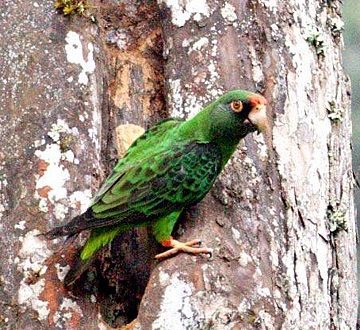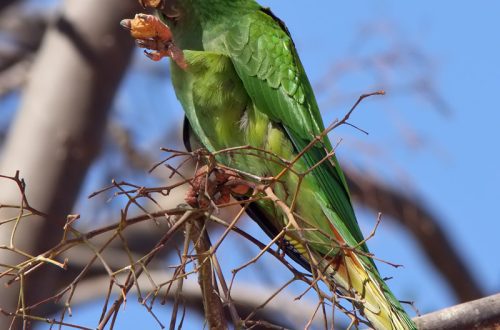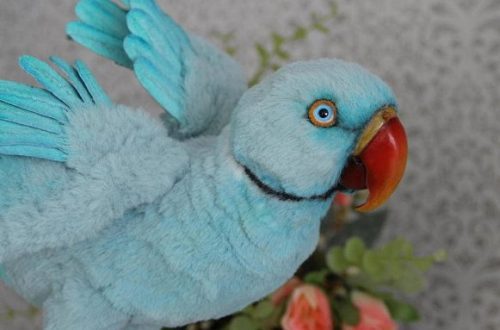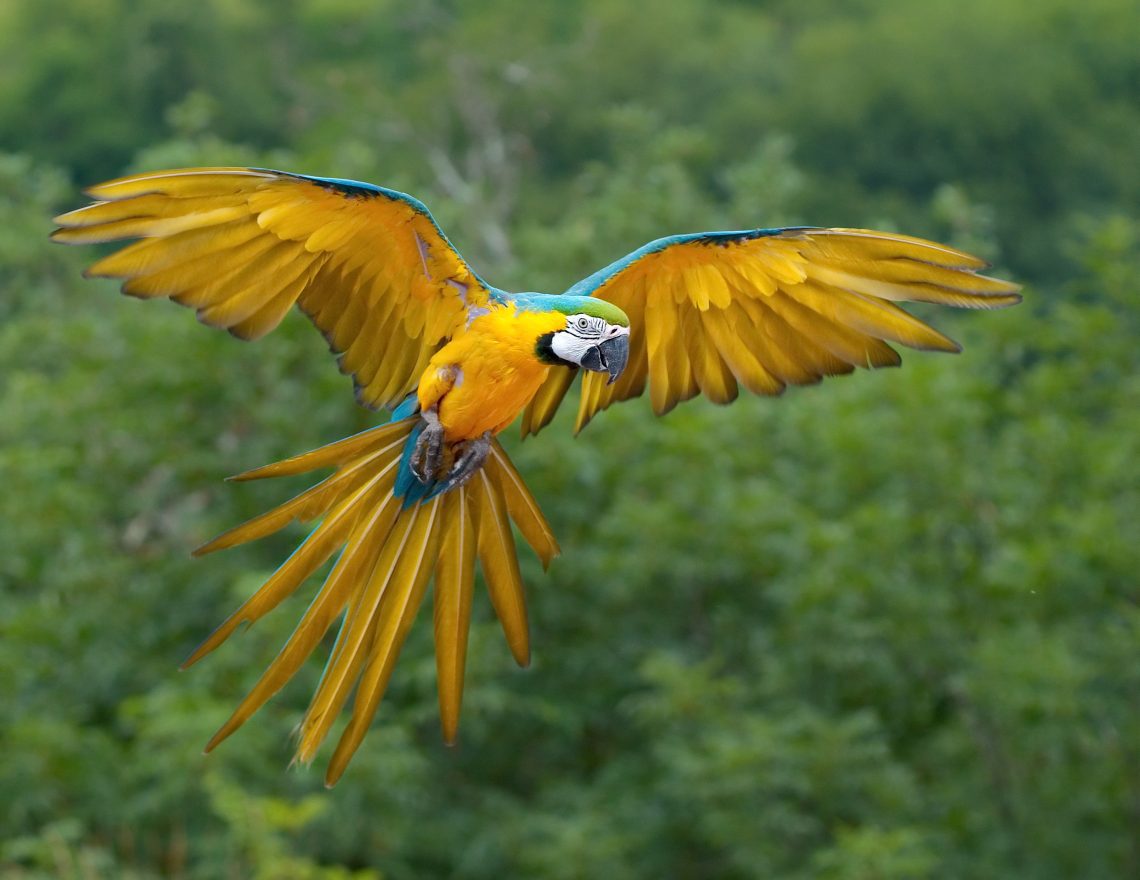
Blue-and-yellow macaw (Ara ararauna)
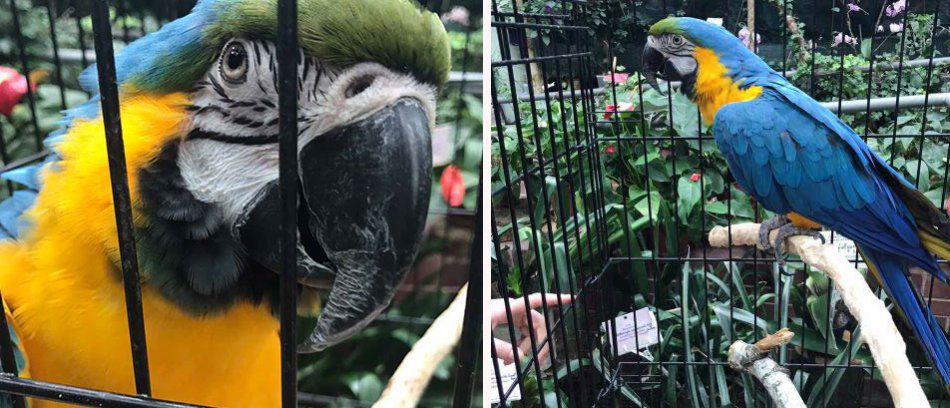
Order | Psittaci, Psittaciformes = Parrots, parrots |
family | Psittacidae = Parrots, parrots |
Subfamily | Psittacinae = True parrots |
Race | Ara = Ares |
View | Ara ararauna = blue-yellow macaw |
Contents
Appearance
The upper part of the plumage of the body is bright blue, the sides of the neck, breast and belly are orange-yellow. The tail coverts are bright blue. Throat black. Cheeks in front unfeathered gray-white with black stripes. The beak is black, very strong and is able to peel nuts and gnaw through tree branches. Legs brownish black. The iris is straw yellow. Length 80-95 cm, weight 900-1300g. The voice is loud and harsh.
Habitat and life in nature
The blue-and-yellow macaw is common in South America, stretching from Panama to Argentina. Under natural conditions, these parrots inhabit dense virgin forests. Very attached to the habitat. They lead a paired or solitary lifestyle, do not form flocks. They nest very high in hollows of trees or build nests on branches. Far from nesting, as a rule, do not fly away. They also settle in mountainous areas up to subalpine meadows, where they live in small flocks or in pairs. They stay in the crowns of tall trees.
Content at home
Character and temperament
Blue and yellow macaws are popular as pets because of their beauty and ability to imitate human speech – they are capable of pronouncing several dozen words. However, they are difficult to maintain and require attention to their person. (at least 1-3 hours a day). With a lack of communication, the blue-and-yellow macaw attracts attention with constant cries. And the strong loud voice of this parrot can annoy not only the owner, but also the neighbors. Especially in the voice of the blue-yellow macaw is in the morning. By nature, the blue-and-yellow macaw is very intelligent, cheerful, playful, brave, loves to dance, some individuals can be jealous, therefore it is strictly forbidden to leave children and pets with a parrot outside the cage. Some people develop allergies to blue and yellow macaws. Sometimes a bird develops sympathy only for a certain gender: for men or women.The blue-and-yellow macaw loves to play, he needs constant physical and mental stress. Therefore, you should provide your pet with a large number of various toys: manipulators, simulators, forages, puzzles, etc. Use toys made only for large parrots, and to stimulate your pet’s interest, change them to new ones at least once a week.
Maintenance and care
Keep in mind that the macaw is a fairly large bird, so it is desirable for it to be kept in an aviary or kept in a separate room. It should not have sources of danger (lattices, sockets, etc.), and the parrot will be able to move and fly freely. If a cage is chosen for keeping, then it should be all-metal, welded, with thick rods. Remember that macaws constantly gnaw on various objects, biting even steel wire. It is better to put padlocks on the cage door, as these smart birds quickly adapt to open constipation. The minimum size of the cage should be 90x90x150 cm. It is placed at a height of 0,9-1,2 m from the floor. The cage should contain a hardwood birdhouse that the macaw will use all year round. Branches of fruit trees are required so that the parrot can gnaw them and sharpen its beak. You will also need a swimsuit with clean water, as the blue-yellow macaw loves to swim. You can spray the bird with a spray bottle. Any material that absorbs moisture well should be placed at the bottom of the cage. Care consists in maintaining cleanliness in the cage or aviary. Every day it is necessary to clean the water bowl, the toy feeders – as they become dirty. It is necessary to wash and disinfect the cage once a week, and clean the bottom daily. The aviary is cleaned and disinfected once a month, and full disinfection is carried out twice a year. Caged parrots are allowed to fly 1-2 times a day in a room where there are no sources of danger.
Feeding
An adult pet blue and yellow macaw should be fed 2 times a day. 60-70% of the entire diet should consist of cereal seeds! Blue-and-yellow macaws, like all large parrots, have a highly developed food conservatism. But, despite their preferences, it is necessary to diversify their diet as much as possible. So, parrots eat vegetables, fruits and berries well (apples, pears, bananas, mountain ash, blueberries, raspberries, persimmons, cherries, peaches in limited quantities). In limited quantities, you can give crackers and fresh Chinese cabbage porridge, dandelion leaves, hard-boiled eggs. From vegetables – carrots and cucumbers. Your macaw will also like peanuts and walnuts. You can give citrus fruits, but only occasionally small pieces and only sweet ones. As often as possible, you should pamper your pet with fresh branches of fruit trees, the bark of which contains minerals and vitamins necessary for birds. The branches can be both small and quite thick – it will not be difficult for a macaw to gnaw them. Water needs to be changed daily.
Breeding
Macaw breeding requires certain conditions. Birds should be kept in an indoor aviary all year round and separately from other birds. A constant air temperature of about 20 ° C and a humidity of 80% must be maintained. In addition to daylight, the room is illuminated with incandescent and fluorescent lamps so that the photoperiod is 15 hours-light, 9 hours-darkness. you can attach a 1,9-liter barrel with a square hole in the end 1,6×2,9 cm or a nesting house with dimensions of 120x17x17cm, the diameter of the round notch is 70 cm, and its height from the bottom of the house is 50 cm. Wood shavings and sawdust are used as nesting litter.



